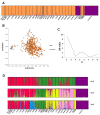Inferring the Origin of Cultivated Zizania latifolia, an Aquatic Vegetable of a Plant-Fungus Complex in the Yangtze River Basin
- PMID: 31787995
- PMCID: PMC6856052
- DOI: 10.3389/fpls.2019.01406
Inferring the Origin of Cultivated Zizania latifolia, an Aquatic Vegetable of a Plant-Fungus Complex in the Yangtze River Basin
Abstract
Crop domestication is one of the essential topics in evolutionary biology. Cultivated Zizania latifolia, domesticated as the special form of a plant-fungus (the host Zizania latifolia and the endophyte Ustilago esculenta) complex, is a popular aquatic vegetable endemic in East Asia. The rapid domestication of cultivated Z. latifolia can be traced in the historical literature but still need more evidence. This study focused on deciphering the genetic relationship between wild and cultivated Z. latifolia, as well as the corresponding parasitic U. esculenta. Twelve microsatellites markers were used to study the genetic variations of 32 wild populations and 135 landraces of Z. latifolia. Model simulations based on approximate Bayesian computation (ABC) were then performed to hierarchically infer the population history. We also analyzed the ITS sequences of the smut fungus U. esculenta to reveal its genetic structure. Our results indicated a significant genetic divergence between cultivated Z. latifolia and its wild ancestors. The wild Z. latifolia populations showed significant hierarchical genetic subdivisions, which may be attributed to the joint effect of isolation by distance and hydrological unconnectedness between watersheds. Cultivated Z. latifolia was supposedly domesticated once in the low reaches of the Yangtze River. The genetic structure of U. esculenta also indicated a single domestication event, and the genetic variations in this fungus might be associated with the diversification of cultivars. These findings provided molecular evidence in accordance with the historical literature that addressed the domestication of cultivated Z. latifolia involved adaptive evolution driven by artificial selection in both the plant and fungus.
Keywords: Ustilago esculenta; Zizania latifolia; approximate Bayesian computation; domestication; genetic structure.
Copyright © 2019 Zhao, Song, Zhong, Li, Chen and Rong.
Figures





References
-
- Barrett S. C. H., Eckert C. G., Husband B. C. (1993). Evolutionary processes in aquatic plant populations. Aquat. Bot. 44 (2-3), 105–145. 10.1016/0304-3770(93)90068-8 - DOI
-
- Beerli P. (2008). Migrate version 3.0: a maximum likelihood and Bayesian estimator of gene flow using the coalescent. Available from http://popgen.scs.edu/migrate.html.
LinkOut - more resources
Full Text Sources

